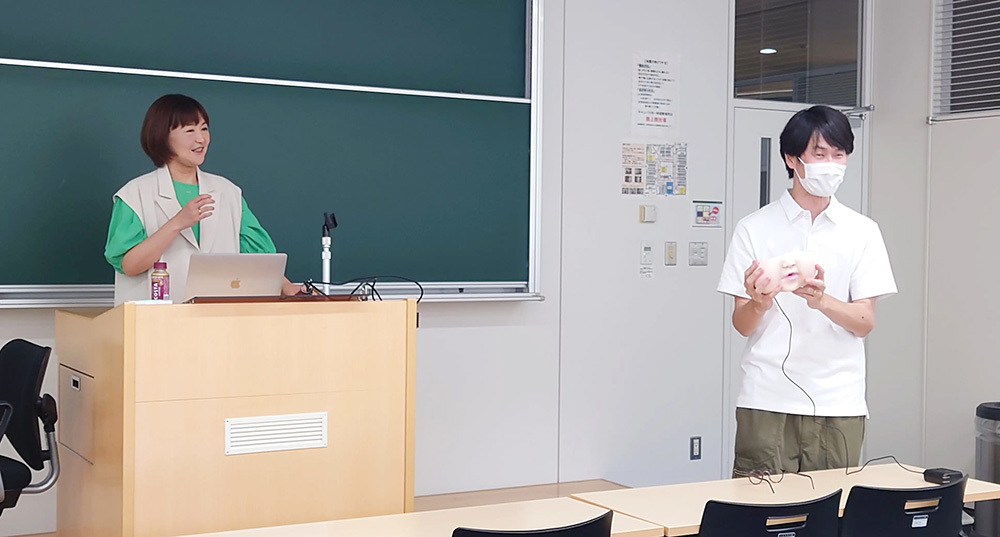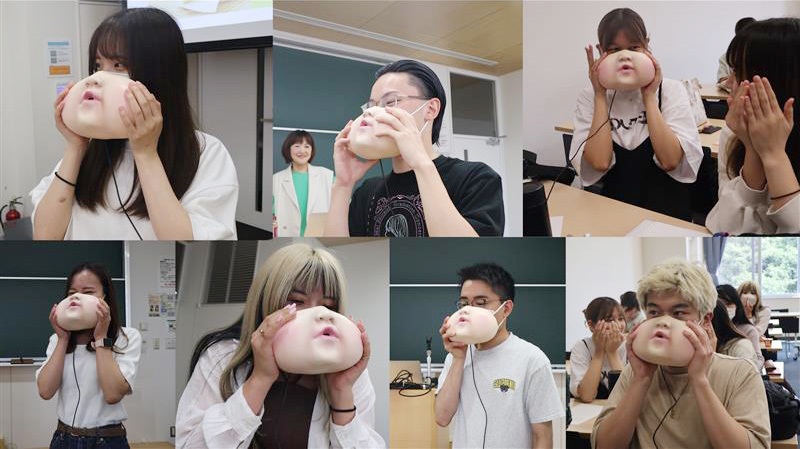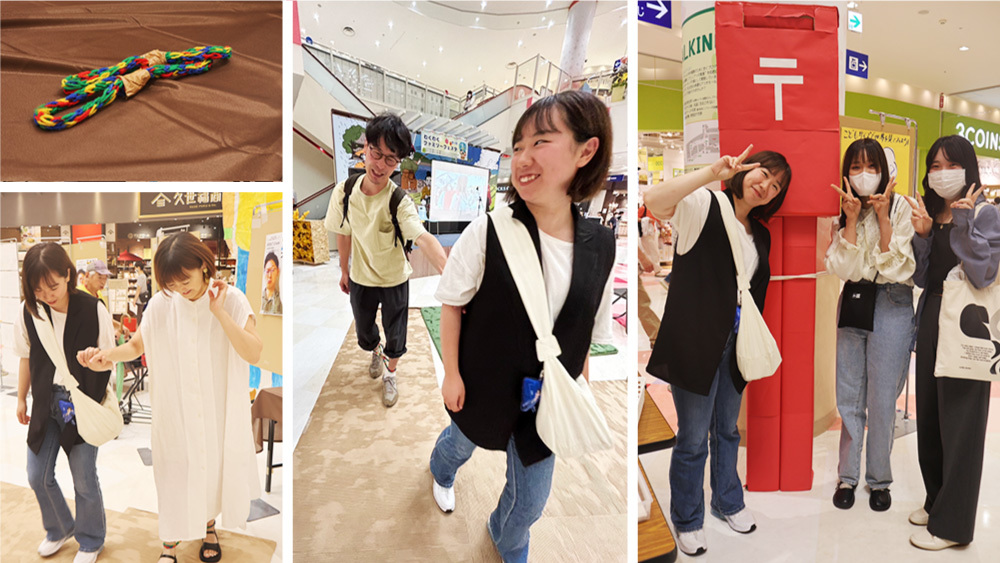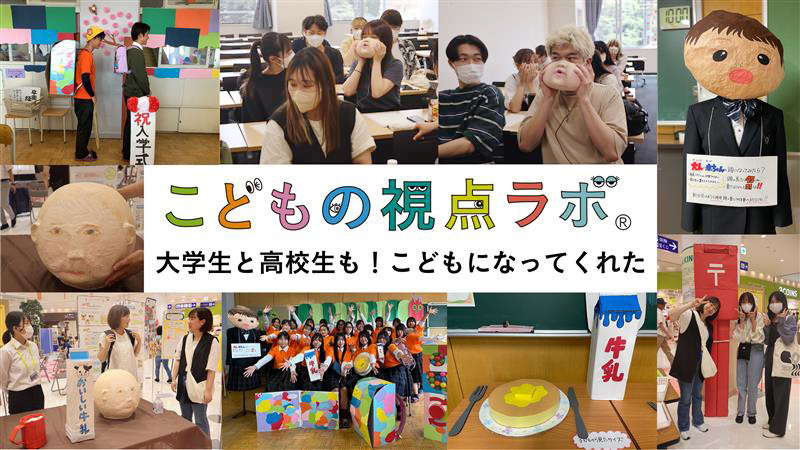The Children's Perspective Lab conducts activities to deepen understanding of children by having adults experience childhood. This time, we'd like to introduce the students who experienced the lab's content, and the "child experiences" they created for events like cultural festivals, inspired by the lab's research!

A scene from the "Children's Perspective Classroom" at Rissho University.
First up: "Children's Perspective Classroom @ Rissho University". Forty students attending Professor Yoko Okamoto's class—who we worked with for Lab Report No. 5 —actually experienced "Baby Voice." Baby Voice converts everything you say into crying sounds. Professor Okamoto advised the students, "Don't just wear it and talk—try to convey what you're thinking to your friends!" Everyone tried hard to communicate their thoughts to their friends, but...
"Wah-wah (Let's eat lunch together!)" "Huh? What's that?"
"Wah-wah (I wanna play games now!)" "What? Say that again?"
"Wah-wah (I'm sleepy. So sleepy!)" "Nah, I don't get it at all"
The sound of babies crying and students laughing filled the university classroom. It was quite a surreal and amusing scene.

Rissho University students experiencing baby talk firsthand.
Ishida: They're students in the Child Education and Welfare Department who aspire to work in childcare and education. They listened intently to all six of our research presentations.
Kutsukake: There were quite a few male students too. Many students have little daily contact with babies, and you could sense their initial hesitation about the baby voice. But it was great that almost everyone tried it. The whole classroom was filled with crying sounds—it was quite the scene (laughs).
Ishida: After the lecture, we heard many heartening comments like, "I truly felt the frustration babies must experience when they can't communicate," and "Before, when I heard a baby crying, I'd just wish they'd stop quickly. Now I want to think about what they're trying to tell us."
Kutsukake: One comment that really stuck with me was: "Even though we talk about being close to children, I felt it was hard to grasp just through imagination. Experiencing it made me realize I can start thinking about how children can lead richer lives and how we can ease their struggles." We, the creators, also felt that even things you understand intellectually can be much harder than imagined when you actually try them.
Ishida: I found the comment, "I believe society can change if we adults shift our perspective to help children live happier lives," to be very encouraging.
Kutsukake: "I was also happy to hear the comment, 'Rather than just thinking about the children, I want to use what I learned this time to support parents struggling with childcare.'" I believe there are words that carry particular weight precisely because they come from the perspective of childcare workers and educators. I really hope they put this into practice!
At the university festival. New ideas like "Child's Stride"!
Ishida: Next, let me introduce the students who created and presented works inspired by our lab's research. They are members of the Seki Seminar in the Department of Early Childhood Education at Ueda Women's Junior College in Nagano Prefecture. For their 2022 festival, they created pieces like "Baby Head," "Breakfast for a 2-Year-Old," and "4m Adults."
The seminar members were working on volunteer activities with the goal of "increasing understanding of children." It all started when Ms. Shomura Erika happened to see a reel video for the " Children's Vision Exhibition " on Instagram and shared it with the whole seminar.
Kutsukake: When I received an email from the seminar students and Professor Yuko Seki asking, "Would it be okay for us to create something for the Culture Festival?", I wondered how students could possibly make a product. But after they sent me videos and photos of the finished work, I was completely blown away. "What?! The children's perspective turned into horror!?" (laughs).
Ishida: It was arranged for the festival with a Halloween-like twist, right?
Kutsukake: They'd adapted it into a slightly horror-themed entertainment piece, and it was utterly charming. You could tell they'd really studied our lab's research to create it, and I was deeply moved by the students' passion.

Production & exhibition scene at Ueda Women's Junior College. Realistic 4m adult-sized exhibit also featured.
Ishida: I was also surprised by the experience of seeing their own ideas take shape.
Kutsukake: The "Child's Stride Experience" was brilliant, right? To make strides feel shorter, they created two connected loops from knitted yarn and attached them to the feet. Participants then walked alongside a student playing an adult to experience it. Simple, yet we thought, "Why didn't we think of that?!" We learned a lot from them.
Ishida: I heard this was conceived by one of the initiators, Aino Maruyama. She came up with it while actually walking hand-in-hand with her little nephew and thinking, "Kids have such different strides from adults—I really need to adjust mine to match theirs."
Kutsukake: We got to try it too, right?
Ishida: Yes. Since the cultural festival was so well-received, it later moved beyond the school to be exhibited at a commercial facility. We visited there and got to experience it too. It really made us realize how fast adults walk (laughs).

Lab members also experience "Child's Stride" / From left: Airi Shomura, Momoh Machida, and Ai Maruyama, who shared their insights
Kutsukake: Regarding stride length, it made us think we'd like to research that ourselves in the future. Also, the box for the questionnaires was designed like a tall mailbox. It was very thoughtful, allowing you to experience a child's perspective right to the end.
Ishida: When we visited the commercial facility, we met a student who helped create an experience for our 2022 cultural festival—she's now thriving as a childcare worker. She told us, "When I interact with children at work, I sometimes remember the lab's research," which made us very happy.
UCV (Ueda Cable Vision) Report coverage of the exhibition: "First-Ever 'Child's Perspective' Approach to Childcare at Ario Ueda" https://ucv.co.jp/program/report/22649/
Colorful exhibits designed by high school students. Photo booth included!
Ishida: Finally, I'd like to introduce the students from Shizuoka Prefectural Fugakukan High School, who also created their own "child experience" exhibit. They presented it at their school festival this November.
Kutsukake: The baby head was made from balloon papier-mâché. To give visitors a realistic sense of its size, they placed it on a body wearing the school uniform and displayed it at the entrance. It had a big impact, and many people stopped to look.
Ishida: It was cute how they displayed the giant milk alongside pancakes. They made the "Adult School Bag" in a colorful rainbow design so anyone could use it, regardless of gender. I thought it was a fun, high-school-student-like idea that they set up a photo booth simulating an entrance ceremony, based on the students' strong desire.
Kutsukake: They were really good at creating displays unique to a "school" setting. Visitors reportedly said things like, "I was surprised by the child's perspective," "I was shocked by the size of the pancake," and "It was cute, colorful, and fun." Many parents also said they found it educational.
Ishida: After the festival, we received handwritten thank-you letters from the students saying things like, "Making everything from scratch helped us understand the challenges children face that we don't normally notice," and "We want to become adults who can support children's growth by applying what we experienced firsthand." All the lab members were very happy reading them.
Kutsukake: It was wonderful to see the younger generation take an interest in "a child's perspective," take initiative themselves, and undertake various projects.
Ishida: Absolutely. It really gave us energy for our next research! So, here's our summary for this time.
● While more people have never actually interacted with babies or young children, we saw firsthand that many young people genuinely want to understand children.
● The lab experience is also an effective tool for students aspiring to childcare or education to tangibly grasp the meaning of "seeing things from a child's perspective."
● Beyond just experiencing, taking proactive actions like creating things themselves or proposing ideas becomes a major driving force for "understanding children" and "interacting appropriately with children." Finally. This year, the Children's Perspective Lab's activities won the Kids Design Award. The "Children's Perspective Exhibition" (Organized by: ITOCHU SDGs STUDIO, Supported by: Children's Perspective Lab) received the Good Design Award, and at the ACC Awards, it won Silver in the PR category, Bronze in the Design category, and Bronze in the Branded Communication category. We are extremely pleased that our research has been recognized. Starting next year, we plan to announce new research and experiences, so please continue to follow the activities of the Children's Perspective Lab!



















